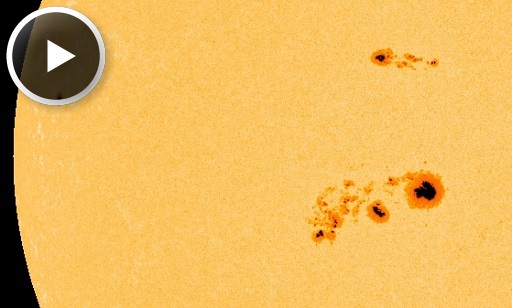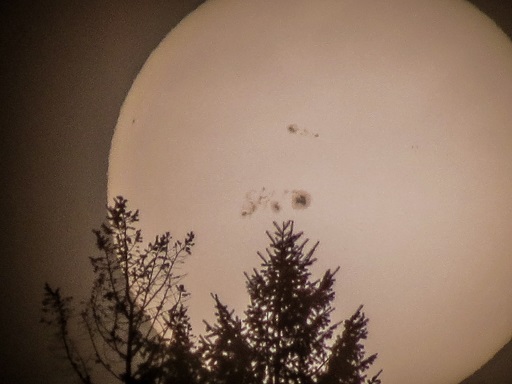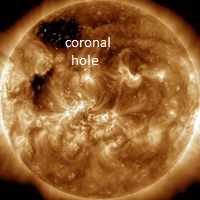CME IMPACT: A coronal mass ejection (CME) hit Earth's magnetic field on Jan. 7th at approximately 1500 UT. The glancing impact did not immediately spark a geomagnetic storm. However, storm conditions could develop as Earth travels through the CME's wake. High latitude sky watchers should remain alert for auroras. Aurora alerts: text, voice.
HUGE SUNSPOT TARGETS EARTH: One of the biggest sunspots in years is crossing the center of the solar disk, putting Earth in the way of potential eruptions. Rocky Raybell photographed the active region named "AR1944" yesterday from his backyard in Keller, Washington:
The sprawling sunspot contains dozens of dark cores, the largest big enough to swallow Earth three times over. This makes it an easy target for amateur solar telescopes -- or even regular cameras. Raybell used an SX40 digital camera on a tripod whole holding a Baader solar filer over the lens to capture his image. Photo details may be found here.
Although AR1944 has been mostly quiet for days, flares are in the offing. The sunspot has an unstable 'beta-gamma-delta' magnetic field that could erupt at any time. NOAA forecasters estimate a 75% chance of M-class flares and a 30% chance of X-flares on Jan. 7th.

Above: A 4-day movie of AR1944 from the Solar Dynamics Observtory
Realtime Space Weather Photo Gallery
VENUS, THE CRESCENT PLANET: Venus is turning its night side toward Earth as it approaches inferior solar conjunction on Jan. 11th. Barely 1% of Venus's sunlit hemisphere is now facing us, which means the planet looks like a razor-thin crescent. If you have a GOTO telescope, command it to slew to Venus. It's visible even in broad daylight:
Shahrin Ahmad of Sri Damansara, Malaysia, took the picture on Jan. 6th using a 4.5 inch telescope. "As Venus gets closer to the sun, it gets thinner everyday!" says Ahmad. "So far, this is the thinnest Venus I've managed to photograph--a mere 9.5o from the sun and just 1.3% illuminated!"

Solar wind
speed: 414.1 km/sec
density: 11.5 protons/cm3
explanation | more data
Updated: Today at 1607 UT
X-ray Solar Flares
6-hr max: M7 1013 UT Jan07
24-hr: M7 1013 UT Jan07
explanation | more data
Updated: Today at: 1600 UT
![]()
Daily Sun: 07 Jan 14
Giant sunspot AR1944 has a 'beta-gamma-delta' magnetic field that harbors energy for X-class solar flares. Credit: SDO/HMI
![]()
Sunspot number: 245
What is the sunspot number?
Updated 07 Jan 2014
Spotless Days
Current Stretch: 0 days
2013 total: 0 days (0%)
2012 total: 0 days (0%)
2011 total: 2 days (<1%)
2010 total: 51 days (14%)
2009 total: 260 days (71%)
Since 2004: 821 days
Typical Solar Min: 486 days
Update 07 Jan 2014
The Radio Sun
10.7 cm flux: 204 sfu
explanation | more data
Updated 07 Jan 2014
![]()
Current Auroral Oval:
Switch to: Europe, USA, New Zealand, Antarctica
Credit: NOAA/POES
![]()
Planetary K-index
Now: Kp= 1 quiet
24-hr max: Kp= 2 quiet
explanation | more data
Interplanetary Mag. Field
Btotal: 5.6 nT
Bz: 3.2 nT south
explanation | more data
Updated: Today at 1607 UT
![]()
Coronal Holes: 07 Jan 14
Solar wind flowing from this emerging coronal hole should reach Earth on Jan. 12-13. Credit: SDO/AIA.






